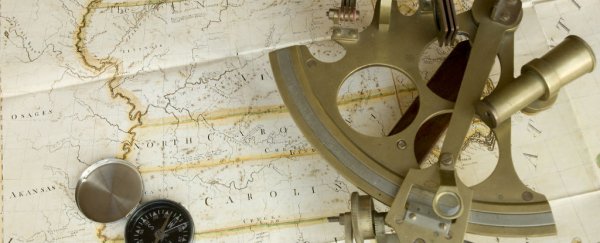As GPS technology steadily becomes better and better, so does our reliance on it. Need to go to the store? Google Maps. Need to go on a road trip to a distant city? Boot up the Garmin. You can even pinpoint why your Uber driver is taking so long to pick you up. At this point, if GPS suddenly vanished, we'd all be a bit confused and upset.
However, the stakes are significantly higher when your job requires you to fly a fighter jet or steer an aircraft carrier, which is why the US Naval Academy has decided to start once again teaching sailors how to navigate with the stars.
Though we all get a little frustrated when our GPS takes us a bad route or loses connection for a few minutes, the Navy is more concerned with deliberate cyberattacks that could render these vital systems useless instead of the actual equipment failing on its own, reports The Washington Post. After all, these systems rely on computer networks, and hackers are only getting better at infiltrating them.
If there's already a way to remotely turn off a Jeep while someone is driving it, it stands to reason for the Navy to have a contingency plan in place if something befalls their GPS. It just so happens that their backup plan is a time-honoured naval tradition dating back hundreds of years.
Motives aside, is celestial navigation accurate? When you consider that there's a huge margin for human error, especially given the fact that navigating the stars still requires the use of a sextant, watch, and map like some old-timey explorer, it seems a bit shaky, but it's totally legit.
According to the Aircraft Owners and Pilots Association (AOPA), the largest aviation association in existence, a well-trained celestial navigator can quickly crunch celestial data to get his plane or ship nearly anywhere they need to go with about a 2-minute accuracy of arrival.
In a world full of precision computers, 2 minutes is a long time. However, it's important to note that the Navy isn't doing away with GPS. They're just making sure pilots and sailors have a backup skillset to complete their missions or get home if something should happen to them.
We all sort of forget that celestial navigation isn't actually some antiquated skill that hasn't been used for hundreds of years. GPS was only invented back in the late-1950s when researchers started tracking Sputnik using radio signals to monitor how they changed based on the satellite's location. You probably know this as the Doppler Effect, which explains how frequencies change based on where the source is from its observer. Up until that point, all navigation was done without the guidance of satellites.
According to NASA, GPS as we know it today really got its start in the 1960s and '70s, when the US military launched a series of satellites to track the position of nuclear submarines. This system eventually grew to 24 satellites in 1993 and has only gotten better since then.
In 1996, the Navy decided to stop teaching celestial navigation at the Naval Academy. This decision was most likely due to the rise of GPS. Now, 20 years later, the Navy is realising that the old way of doing things had one thing going for it: security. It may not have the pinpoint accuracy or ease of use, but at least a hacker in some far off location couldn't change the sky on a pilot.
Like any skill, celestial navigation is something that comes with loads of practice. Sailors at the Naval Academy will need to practice these skills on a regular basis if they intend on knowing how to use them in an emergency situation. In a way, celestial navigation is like performing math with pen and paper. Sure, we have calculators to do all that for us nowadays, but that doesn't mean that kicking it old-school is wrong. It just requires a bit a patience and know-how.
